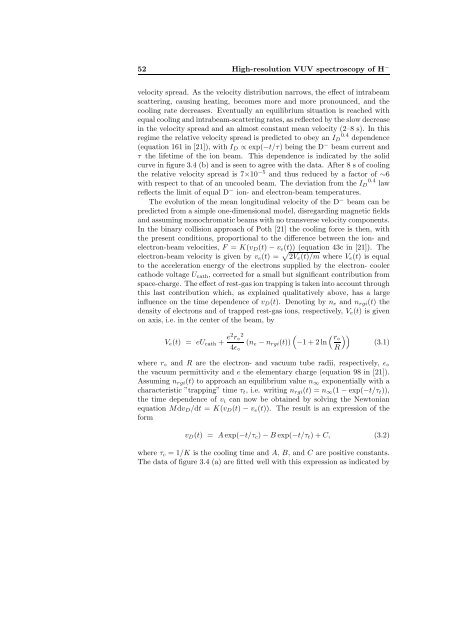VUV Spectroscopy of Atoms, Molecules and Surfaces
VUV Spectroscopy of Atoms, Molecules and Surfaces
VUV Spectroscopy of Atoms, Molecules and Surfaces
Create successful ePaper yourself
Turn your PDF publications into a flip-book with our unique Google optimized e-Paper software.
52 High-resolution <strong>VUV</strong> spectroscopy <strong>of</strong> H −<br />
velocity spread. As the velocity distribution narrows, the effect <strong>of</strong> intrabeam<br />
scattering, causing heating, becomes more <strong>and</strong> more pronounced, <strong>and</strong> the<br />
cooling rate decreases. Eventually an equilibrium situation is reached with<br />
equal cooling <strong>and</strong> intrabeam-scattering rates, as reflected by the slow decrease<br />
in the velocity spread <strong>and</strong> an almost constant mean velocity (2–8 s). In this<br />
regime the relative velocity spread is predicted to obey an ID 0.4 dependence<br />
(equation 161 in [21]), with ID ∝ exp(−t/τ) beingtheD − beam current <strong>and</strong><br />
τ the lifetime <strong>of</strong> the ion beam. This dependence is indicated by the solid<br />
curve in figure 3.4(b) <strong>and</strong> is seen to agree with the data. After 8 s <strong>of</strong> cooling<br />
the relative velocity spread is 7×10 −5 <strong>and</strong> thus reduced by a factor <strong>of</strong> ∼6<br />
with respect to that <strong>of</strong> an uncooled beam. The deviation from the ID 0.4 law<br />
reflects the limit <strong>of</strong> equal D − ion- <strong>and</strong> electron-beam temperatures.<br />
The evolution <strong>of</strong> the mean longitudinal velocity <strong>of</strong> the D − beam can be<br />
predicted from a simple one-dimensional model, disregarding magnetic fields<br />
<strong>and</strong> assuming monochromatic beams with no transverse velocity components.<br />
In the binary collision approach <strong>of</strong> Poth [21] the cooling force is then, with<br />
the present conditions, proportional to the difference between the ion- <strong>and</strong><br />
electron-beam velocities, F = K(vD(t) − ve(t)) (equation 43c in [21]). The<br />
electron-beam velocity is given by ve(t) = � 2Ve(t)/m where Ve(t) isequal<br />
to the acceleration energy <strong>of</strong> the electrons supplied by the electron- cooler<br />
cathode voltage Ucath, corrected for a small but significant contribution from<br />
space-charge. The effect <strong>of</strong> rest-gas ion trapping is taken into account through<br />
this last contribution which, as explained qualitatively above, has a large<br />
influence on the time dependence <strong>of</strong> vD(t). Denoting by ne <strong>and</strong> nrgi(t) the<br />
density <strong>of</strong> electrons <strong>and</strong> <strong>of</strong> trapped rest-gas ions, respectively, Ve(t) isgiven<br />
on axis, i.e. in the center <strong>of</strong> the beam, by<br />
Ve(t) = eUcath + e2 r◦ 2<br />
4ɛ◦<br />
� � ��<br />
r◦<br />
(ne − nrgi(t)) −1+2ln<br />
R<br />
(3.1)<br />
where r◦ <strong>and</strong> R are the electron- <strong>and</strong> vacuum tube radii, respectively, ɛ◦<br />
the vacuum permittivity <strong>and</strong> e the elementary charge (equation 98 in [21]).<br />
Assuming nrgi(t) to approach an equilibrium value n∞ exponentially with a<br />
characteristic ”trapping” time τt, i.e. writing nrgi(t) =n∞(1 − exp(−t/τt)),<br />
the time dependence <strong>of</strong> vi can now be obtained by solving the Newtonian<br />
equation MdvD/dt = K(vD(t) − ve(t)). The result is an expression <strong>of</strong> the<br />
form<br />
vD(t) = A exp(−t/τc) − B exp(−t/τt)+C, (3.2)<br />
where τc =1/K is the cooling time <strong>and</strong> A, B, <strong>and</strong>C are positive constants.<br />
The data <strong>of</strong> figure 3.4(a) are fitted well with this expression as indicated by















